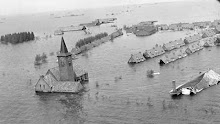Life list now 215 species
Even though Aden seemed to have eternal summer to someone coming from northern climes, there were seasons. It was hotter in July than January and, more important for the birds, there was an alternation of wet and dry influences. As already mentioned, southwest Arabia is a continuation eastwards of the Sahel zone of Africa and is subject to monsoon rains. These generally fall in the summer, April to October, with a peak in July and August. In fact, a belt of rain follows the sun in the equatorial zone and moves north in the northern summer and south in the southern summer. Though Aden experiences little of this rain, it falls heavily in the mountains of Yemen to the north. The rain causes vegetation to grow and insects to flourish. Birds follow the rain belt and travel north from Africa to take advantage of the plentiful food.
 Many birds anticipate the seasonal change in the area to which they are migrating so as to have young birds already hatched when the peak of food abundance arrives. It was one such bird that amazed me by its exotic appearance, even from a brief glimpse at Steamer Point on 5 May 1946. “From the billet I saw an unidentified species fly from the hillside to near Tarshyne. Size about as Starling [Sturnus vulgaris] or thrush, general colour very bright cobalt blue, apparently black or dark shoulders and bright red bill and head (?)” Because of the arid habitat I did not guess that it was, in fact, a kingfisher, though the brilliant blue in the plumage should have given me a clue. A few years previously I had found a dead Kingfisher Alcedo atthis in England and had made a display of the iridescent turquoise feathers from the back and wings. In fact, as I found out later, the Aden bird was a ___________________________*. I was not the first to observe this species in Aden. It had been reported by Barnes (1893) in January and by Yerbury (1896) in April.
Many birds anticipate the seasonal change in the area to which they are migrating so as to have young birds already hatched when the peak of food abundance arrives. It was one such bird that amazed me by its exotic appearance, even from a brief glimpse at Steamer Point on 5 May 1946. “From the billet I saw an unidentified species fly from the hillside to near Tarshyne. Size about as Starling [Sturnus vulgaris] or thrush, general colour very bright cobalt blue, apparently black or dark shoulders and bright red bill and head (?)” Because of the arid habitat I did not guess that it was, in fact, a kingfisher, though the brilliant blue in the plumage should have given me a clue. A few years previously I had found a dead Kingfisher Alcedo atthis in England and had made a display of the iridescent turquoise feathers from the back and wings. In fact, as I found out later, the Aden bird was a ___________________________*. I was not the first to observe this species in Aden. It had been reported by Barnes (1893) in January and by Yerbury (1896) in April. At about the time I saw this bird, there were, as already recounted, obvious signs of migration of birds through Aden bound for their breeding grounds far to the north, where the return of warm weather would bring about a vast increase in food supply. I had been very familiar with this type of migration in England. I did not realize that the bird I had just seen was my first encounter with a different class of migration, intra-tropical, which takes place within the tropics and is driven by the annual passage north and south of the rains. I would later in life come across the _______________ performing its migration in other parts of the Sahel right across Africa, almost as far west as the Atlantic coast of Mauritania.
I obtained proof of its destination further north when I visited Lahej on 7 July 1946. Lahej was 15-20 miles north of Aden and was watered by a river that flowed down from the mountains of Yemen even further north. Surprisingly, I did not apparently link these birds with what I had seen at Steamer Point on 5 May >>>
"Another bird was quite common and about the most striking there. In size it equaled, approximately, a Starling but the head and bill were comparatively very large and the tail a little longer. Head, neck and upper breast were a very light grey or grey-pink, black around eye (?), mantle (?), part of upper wings and primaries (only) black or very dark blue, rest of upper parts (including tail) very vivid blue. In flight this combination of black and blue on the upper parts was very noticeable. I'm not quite clear on the colour of the underparts but they were definitely darkish and showed up the whitish neck etc. Bill was a bright coral or orange red, legs a pinkish red. In flight this showed plainly together with a white patch beneath each wing. This bird spent a great deal of time calling "chwik" repeatedly as "jek-ek-ek-ek-.." or "jek-je-je-jek..." making the notes jumbled when calling them in fast succession. Once it dived with a splash into a pool of water rather like a kingfisher."
QUIZ: If you think you know what species this bird was, please put its name, your name, how you identified it and the date (5 May 1946) in the comment box at the end of this post.


